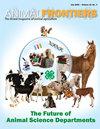牛肉生产性能提升技术
IF 3.2
2区 农林科学
Q1 AGRICULTURE, DAIRY & ANIMAL SCIENCE
引用次数: 8
摘要
联合国粮农组织预测,到2050年,全球人口将从目前的70亿增加到95亿,对肉类、牛奶和鸡蛋的需求将增加70%(粮农组织,2009年)。在过去几十年中,禽肉的总消费量和人均消费量增长最快,而牛肉消费量也增长了18%(1990年至2009年)。因此,畜牧业面临着投资于提高效率的技术的压力,例如,由于人口增长,对可用土地、水、植物来源的食物和能源的竞争加剧,因此使用更少的资源生产更多的肉。虽然过去的技术主要集中在不惜一切代价提高生产率,例如生长率、饲料效率和屠宰单位体重的增加(Capper, 2011)(图1),但Capper和Hayes(2012)和其他研究强调了在需求驱动的市场中承诺可持续性、考虑环境影响和动物福利以维持社会许可的重要性。进一步考虑到适口性的变化是20世纪80年代和90年代澳大利亚和美国牛肉消费量下降的主要原因(宾登和琼斯,2001;Howard et al., 2013),粗心地使用对食用质量产生负面影响的技术将影响消费者对牛肉的态度。提高性能的技术可能包括遗传学,饲料技术和饲养策略,生长促进物质和管理策略,仅提一些,但不是全部。我们专注于提高性能的选定技术,但同时,我们也考虑了它们与可持续性、动物福利和产品质量的关系。本文章由计算机程序翻译,如有差异,请以英文原文为准。
Performance-enhancing technologies of beef production
The Food and Agriculture Organization predicts that the global population will increase from the current 7 billion people to 9.5 billion by the year 2050 and will need 70% more meat, milk, and eggs (FAO, 2009). While the total and per capita consumption of poultry meat enjoyed the largest growth over the past decades, beef consumption also increased 18% (1990 to 2009). The livestock industry is therefore under pressure to invest in technologies that will increase efficiency, e.g., using fewer resources to produce more meat since competition for available land, water, food from plant origin, and energy intensifies due to the growing population. While technologies in the past mostly focused on improving productivity, e.g., growth rate, feed efficiency, and increased weight of the slaughter unit (Capper, 2011) at all cost (Figure 1), Capper and Hayes (2012) and other studies emphasized the importance of commitment to sustainability, consideration of environmental impact, and animal welfare to maintain the social license in a demand-driven market. When further considering that variability in palatability were the major reasons for decline in beef consumption in Australia and the USA during the 1980s and 1990s (Bindon and Jones, 2001; Howard et al., 2013), careless utilization of technologies that impact negatively on eating quality will influence the consumer’s attitude toward beef. Performance-enhancing technologies may include genetics, feed technologies and feeding strategies, growth-enhancing substances, and management strategies to mention some but not all. We focused on selected technologies that enhance performance, but at the same time, we also considered their relationships to sustainability, animal welfare, and product quality.
求助全文
通过发布文献求助,成功后即可免费获取论文全文。
去求助
来源期刊

Animal Frontiers
Veterinary-Food Animals
CiteScore
6.50
自引率
5.60%
发文量
74
期刊介绍:
Animal Frontiers is the official journal of the following globally active professional animal science societies:
ASAS, the American Society of Animal Science
CSAS, the Canadian Society of Animal Science
EAAP, the European Federation of Animal Science
AMSA, the American Meat Science Association
These organizations are dedicated to the advancement and dissemination of science-based knowledge concerning animal agriculture. Animal Frontiers provides a novel forum for innovative and timely perspectives that have relevance to understanding the complex dynamics at work through animal agriculture. Animal Frontiers publishes discussion and position papers that present several international perspectives on the status of high-impact, global issues in animal agriculture. Every issue will explore a theme of broad and current interest within animal science and animal agriculture.
 求助内容:
求助内容: 应助结果提醒方式:
应助结果提醒方式:


